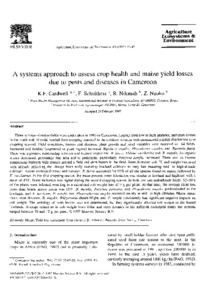| dc.contributor.author | Cardwell, K.F. |
| dc.contributor.author | Schulthess, F. |
| dc.contributor.author | Ndemah, R. |
| dc.contributor.author | Ngoko, Z. |
| dc.date.accessioned | 2019-12-04T11:23:35Z |
| dc.date.available | 2019-12-04T11:23:35Z |
| dc.date.issued | 1997 |
| dc.identifier.citation | Cardwell, K.F., Schulthess, F., Ndemah, R. & Ngoko, Z. (1997). A systems approach to assess crop health and maize yield losses due to pests and diseases in Cameroon. Agriculture, Ecosystems & Environment, 65(1), 33-47. |
| dc.identifier.issn | 0167-8809 |
| dc.identifier.uri | https://hdl.handle.net/20.500.12478/4043 |
| dc.description.abstract | Three surveys of maize fields were undertaken in 1993 in Cameroon, ranging from low to high altitudes, and from forests in the south with bimodal rainfall (two cropping seasons) to the northern savanna with monomodal rainfall distribution (one cropping season). Field conditions, insects and diseases, plant growth and yield variables were assessed in 164 fields. Increased soil fertility (expressed as plant vigour) favoured Bipolaris maydis, Physoderma maydis, and Busseola fusca. There was a positive relationship between soil organic matter and B. fusca, Eldana saccharina and B. maydis. As organic matter decreased, percentage leaf area lost to pathogens, particularly Puccinia sorghi, increased. There was an inverse relationship between wild grasses around a field and stem borers in the field. Stem diameter, cob fill and weight increased with altitude reflecting the change from early maturing lowland cultivars to very late maturing mid- to high-altitude cultivars. Across ecological zones and surveys, B. fusca accounted for 95% of all the species found on maize, followed by E. saccharina. In the first cropping season, the mean percent borer infestation was similar in lowland and highland with a mean of 43%. Borer incidence was higher during the second cropping season. In both low and mid-altitude fields, 52–56% of the plants were infested, resulting in a calculated cob weight loss of 9 g per plant. At that time, the average plant loss from dead hearts across zones was 11%. B. maydis, Puccinia polysora, and Physoderma maydis predominated in the lowlands, and E. turcicum, P. sorghi, and Phaeosphaeria maydis occurred mainly in mid- to high-altitudes. Maize streak virus, stem diseases, B. maydis, Rhizoctonia sheath blight, and P. sorghi consistently had significant negative impacts on cob weight. The aetiology of stem lesions was not determined, but they significantly affected cob weight in the humid lowlands. Average reduction in cob weight from foliar and stem diseases in the different ecological zones and seasons ranged between 10 and 12 g per plant. |
| dc.language.iso | en |
| dc.subject | Maize |
| dc.subject | Yield Loss Assessment |
| dc.subject | Crop Diseases |
| dc.subject | Stem Borers |
| dc.subject | Busseola Fusca |
| dc.subject | Survey |
| dc.title | A systems approach to assess crop health and maize yield lossess due to pests and diseases in Cameroon |
| dc.type | Journal Article |
| dc.description.version | Peer Review |
| cg.contributor.affiliation | International Institute of Tropical Agriculture |
| cg.contributor.affiliation | Institut de Recherche Agronomique, Cameroon |
| cg.coverage.region | Africa |
| cg.coverage.region | Central Africa |
| cg.authorship.types | CGIAR and developing country institute |
| cg.iitasubject | Maize |
| cg.iitasubject | Plant Diseases |
| cg.iitasubject | Pests Of Plants |
| cg.iitasubject | Impact Assessment |
| cg.iitasubject | Plant Breeding |
| cg.iitasubject | Climate Change |
| cg.accessibilitystatus | Limited Access |
| local.dspaceid | 99329 |
| cg.identifier.doi | https://doi.org/10.1016/S0167-8809(97)00056-X |

